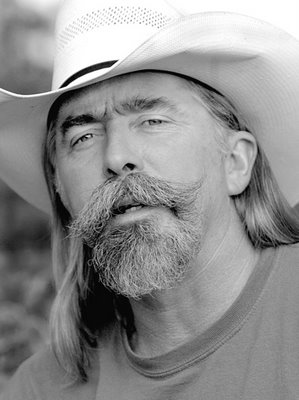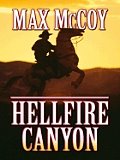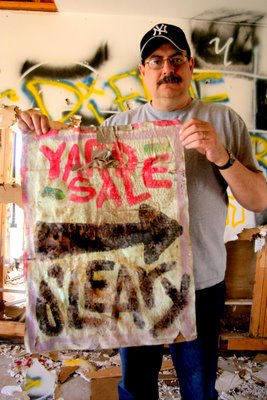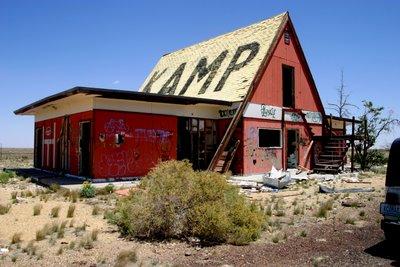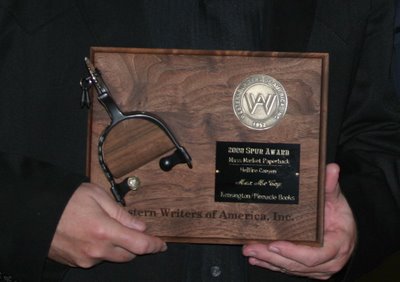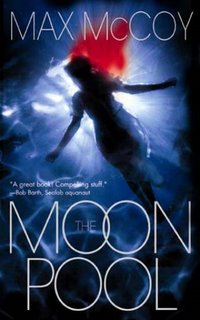Monday, December 22, 2008
See you next year
Sunday, November 23, 2008
Moon Pool unabridged audio book
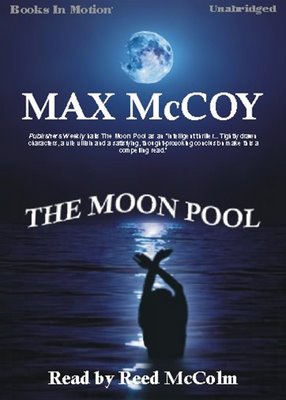 It was a week for surprises.
It was a week for surprises.THE MOON POOL, my 2004 thriller from Leisure, has just been released as an 11-hour unabridged book on tape by Books In Motion. I know, because it's on their website under "Just in."
So, for $57.95 you can buy the CD Library Package. Or, you can rent it for $9.95 or own it as an MP3 download for $14.95. Also, I can't resist the urge to point out that you could have owned the original paperback for seven bucks. But then, you wouldn't be able to listen to it in the car, would you?
As I've lamented before, the author is always the last to know. Seems like some money should have shown up at my door in connection with this. Guess I'll make some calls.
At least the cover is cool.
Tuesday, November 18, 2008
What the hell?
Here's the relevant part of my review:-
Rollins has clearly taken the time to read up on the VMs and to engage with its strange pictures, for which I applaud him (I even get a brief mention in the notes at the end, which is nice, however unwarranted). Unfortunately, one thing manages to spoil the whole party.
Briefly, what happens is: hero goes to the British Museum/Library to meet man studying the alchemical side of the Voynich Manuscript; because the man has disappeared, the hero instead meets his sister (who also happens to work there); they go to a pub in the East End; hero learns about the womans mysterious Celtic tattoo on her back; Nazi thugs enter the pub; she produces a key from above the back door; they escape out to the rear into a messy gunfight& and when the woman is eventually captured by the Nazis, her tattoo turns out to contain an ancient map / key to the secrets hidden in the Voynich Manuscript.
The problem is that this central storyline exactly reprises probably the best-selling (and quite possibly the best-written) Voynich novel yet, Max McCoy's (1995) Indiana Jones and the Philosopher's Stone - you know, the one I recommend that all aspiring Voynich novelists should read first. If there had been just a handful of similarities, I could possibly have passed over them in silence - but this is all much too much for me to bear.
http://www.ciphermysteries.
Cheers, ....Nick Pelling.... // Cipher Mysteries
Monday, November 3, 2008
Lower Fox Creek School
Sunday, October 19, 2008
What the dead know
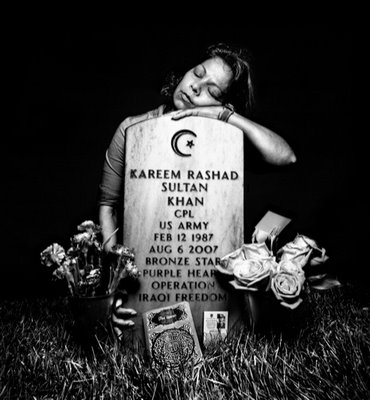 Have you ever heard of a photo essay being cited in a presidential race? Well, Colin Powell did it this morning on Meet the Press.
Have you ever heard of a photo essay being cited in a presidential race? Well, Colin Powell did it this morning on Meet the Press.Powell, the former Secretary of State who lost street cred when he stumped for the Bush Doctrine at the UN, said that he was moved by an image in a recent photo essay depicting a mother at the grave of her soldier son. The point, Powell said, is that the son -- who was 20 when he died in service of his country -- was a Muslim, something his party has suggested is unpatriotic.
"I feel strongly about this particular point because of a picture I saw in a magazine," Powell said, referring to the Sept. 29 issue of The New Yorker. "It was a photo essay about troops who are serving in Iraq and Afghanistan. And one picture at the tail end of this photo essay was of a mother in Arlington Cemetery, and she had her head on the headstone of her son's grave."
The photo essay is by 40-year-old New York photographer Platon (yes, he is professionally known only by his first name). Fifteen years ago, British Vogue named him the best up-and-coming photographer.
"You could see the writing on the headstone," Powell said. "And it gave his awards--Purple Heart, Bronze Star--showed that he died in Iraq, gave his date of birth, date of death. He was 20 years old. And then, at the very top of the headstone, it didn't have a Christian cross, it didn't have the Star of David, it had crescent and a star of the Islamic faith. And his name was Kareem Rashad Sultan Khan, and he was an American. He was born in New Jersey. He was 14 years old at the time of 9/11, and he waited until he can go serve his country, and he gave his life. Now, we have got to stop polarizing ourself in this way."
Friday, October 17, 2008
The Texan
Wednesday, October 15, 2008
Extra money is always helpful
WASHINGTON — The chief executives of the nine largest banks in the United States trooped into a gilded conference room at the Treasury Department at 3 p.m. Monday. To their astonishment, they were each handed a one-page document that said they agreed to sell shares to the government, then Treasury Secretary Henry M. Paulson Jr. said they must sign it before they left.
There was no press at this invitation-only meeting, but Mark Landler and Eric Dash did an admirable job of recreating it from interviews. It was, in short, a $250 billion offer the banks couldn't refuse.
Even as they insisted that they did not need the money, bankers recognized that the extra capital could be helpful if the economy became shakier. Besides, many of these banks’ biggest businesses are tied to the stock and credit markets; the quicker they improve, the better their results.
This is just obscene.
Wednesday, October 8, 2008
Wake me when it's over
The theme this year is "Public Notice: Good Government on Display" and the Newspaper Association Managers (NAM on second reference) have offered a downloadable press kit. The aim of the editorials and cartoons and crossword is that it's important for government to keep running paid legal notices in newspapers because, well, it's oh so much better than the free Internet.
"Why in the world should governmental entities spend taxpayers’ money on public notices when they can post them on the Internet for next to nothing?" gushes one canned editorial. "Because the taxpayers have a right to know, have a need to know and want to know, that’s why. The argument is as simple as that."
Not sure I can get worked up about a campaign aimed at convincing local governments keep buying ad space for legals. I'd be more enthused if NAM didn't have such a clear profit motive. The key to better government isn't more advertising, it's investing money on watchdog reporting.Speaking of which, National Sunshine Week is March 15-21. Now, there's a week to get excited about.
Friday, October 3, 2008
Financial felo-de-se
At least the Kansas delegation stuck to their guns, if I'm reading the record correctly. Their vote was 3-4 against, just as it was the first time. I understand why Dennis Moore, a Lenexa Democrat, voted for the bailout, but I still disagree.
Meanwhile, 90-year-old Addie Polk, shot herself twice while deputies were attempting to evict her from her home in Akron, Ohio. A neighbor, who climbed in through a window and found the wounded woman, said, "Oh, no. Miss Polk musta done shot herself."
Fannie Mae, which had assumed Polk's $45,620 mortgage from Countryside after she began missing payments, announced today they had forgiven the loan. CNN reports that Addie Polk is recovering in an Ohio hospital.
I wonder if she had health insurance.
Miss Polk has
Of course I understand it would have been hard not to. But it is still a bad idea. It's a shell game, a con, and things got much worse because the administration and its cronies created a climate in which there was no confidence in the economy -- so, it became a self-fulfilling prophecy. So, we've nationalized at $700 billion in bad debt and helped those who deserved it least.
Monday, September 29, 2008
Fiefdom of the Crystal Skull
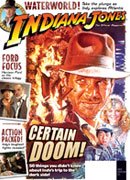 Had a telephone interview this morning with Paul Simpson, who is writing a piece on my Indy novels for the official Indiana Jones magazine. He's a nice chap (he and the magazine reside in England) and he did me the courtesy not only of reading the Indy books, but also my most recent novel, I, QUANTRILL.
Had a telephone interview this morning with Paul Simpson, who is writing a piece on my Indy novels for the official Indiana Jones magazine. He's a nice chap (he and the magazine reside in England) and he did me the courtesy not only of reading the Indy books, but also my most recent novel, I, QUANTRILL.Refreshing.
But, you'd expect this kind of preparation from somebody who wrote The Bond Files: The Unofficial Guide to World's Greatest Secret Agent. Paul asked informed -- and sometimes difficult -- questions. Like, my reaction when I learned that the title for Indy IV was "Kingdom of the Crystal Skull." I don't think he'll be able to print my answer, at least not verbatim.
He also asked me what it was like to create the backstories for Belloq and Sallah (that was fun), and which of the novels was my personal favorite (HOLLOW EARTH). He also asked if I meant what I said about passing the hat and whip in the afterword to the last novel.
Yep, I meant it.
Christ, I'm a Republican
Republicans voted 2-1 against the bill (although both the GOP and Democrat leadership backed the administration's plan). The Kansas Congressional delegation voted against it by a margin of 3-1. Republicans Jerry Moran and Todd Tiahrt both voted no, along with Dem Nancy Boyda. Dennis Moore, an Overland Park Democrat, was the only Kansan to vote in favor of the bailout.
There must be something seriously wrong with the universe if my thinking not only matches that of most GOP members, but also of the Kansas delegation. The world as we once knew it has truly ended. And faced with a vote of no confidence, Wall Street lost $1.2 trillion in the biggest point drop ever. In terms of percentages, however, the drop didn't even make the top 10, so it's not curtains yet.
Don't be fooled again
"We sent a message to Wall Street -- the party is over," Pelosi said after an "improved" $700 billion bipartisan bailout agreement was hammered out between House and Senate leaders on Sunday, CNN reported.
Well, no. The message being sent to Wall Street is that no matter how badly you fuck up, the government will always be there for you. All you have to do is to fail big -- the bigger the better, in fact. And have powerful friends.
But if you're a working stiff, forget it. The full force of the government will come down on you like a ton of bricks if you can't pay your taxes, or default on your mortgage, or fall behind on your credit cards because you get sick. The government passed a battery of laws in the last 10 years that made it tougher for those behind the eight ball. They tightened the bankruptcy laws and gave lenders, especially credit card companies, unprecedented power to unilaterally change the terms of your loan.
And don't kid yourself, the splurge won't work.
At no time since the Great Depression has there been such an unequal distribution of wealth. The top 1 percent take 80 percent of the wealth. And while those on the bottom have increased productivity by 20 percent, wages have remained stagnant or lost ground to inflation.
No wonder the average American is outraged and calls to Congress against the bailout have been running 200-1. How, in hell, could Congress then hammer out a deal to pass it in the face of such opposition? Because, once again, the administration has used fear to manipulate the political process. But the bailout won't work. It's a stunt, really, designed to instill confidence and to shield the rich from their own folly.
Allan Sloan, senior editor at large at Fortune Magazine, has this to say:
"The proposed bailout of the world's financial system isn't really about money, folks. It's about psychology. In fact, you can think of it as the most expensive piece of psychotherapy in the history of the world."
Friday, September 26, 2008
Larwrence reprise
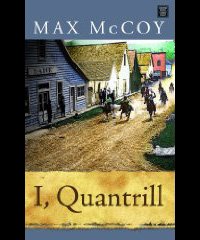 Those quirky free staters will get another shot at me this weekend, when I appear at the second annual River City Reading Festival. At about 10 in the morning, I'll be reading an excerpt from I, QUANTRILL, just in case there are any Lawrence residents who aren't pissed off yet.
Those quirky free staters will get another shot at me this weekend, when I appear at the second annual River City Reading Festival. At about 10 in the morning, I'll be reading an excerpt from I, QUANTRILL, just in case there are any Lawrence residents who aren't pissed off yet.The novel, which is a first-person narrative of the final weeks of the notorious guerrilla chieftain William Clarke Quantrill, inflamed the editorial board of the Lawrence Journal-World. Why, they asked a bit snarkily, should they care if Quantrill had a difficult relationship with his mother?
Well, it probably contributed to Quantrill's decision to burn Lawrence to the ground in 1863... But, you have to give the Lawrence paper credit. They are quick to step up and bravely challenge a foe that's been dead for 143 years.
Seriously, I've heard from many Lawrentians who say they get that the book is a work of fiction. They say that anybody who reads the novel realizes that while Quantrill is portrayed as a human being, he isn't a hero.
To form your own opinion, please read the damned book.
Thursday, September 25, 2008
Sounds good to me
Wednesday, September 24, 2008
Not only no, but hell no!
 In his address to the nation tonight, President Bush said that immediate action was needed, in the form of a $700 billion bailout of mortgage-based securities. "We're in the midst of a serious financial crisis, and the federal government is responding with decisive actions," CNN reported Bush as saying.
In his address to the nation tonight, President Bush said that immediate action was needed, in the form of a $700 billion bailout of mortgage-based securities. "We're in the midst of a serious financial crisis, and the federal government is responding with decisive actions," CNN reported Bush as saying.But Bush urging quick action on anything is enough to make me think doing nothing is the best course.
More and more, this emergency bailout seems geared to protecting Bush's monied friends rather than saving the economy. It is as if the administration decided to loot the treasury in the weeks they have left, stuffing their pockets with everything they can get. It's the same as waging a largely privatized war so that your friends, the Blackwaters and Halliburtons of the world, can get rich.
This economic crisis was nearly 30 years in building. The people who created it all got rich and will stay rich, what with their multi-billion dollar bonuses and golden parachute deals. I'm thinking, what is worse? Plunging taxpayers another $700 billion in debt? And you know the way the government estimates costs, it could really be a trillion dollars or more. A trillion dollars. This will devalue an already beleaguered dollar, once the international standard for economic stability. And when the dollar slips, rampant inflation will begin. When that happens, Wall Street will take Main Street down with it.
So, let's do nothing and see where we're at when the dust settles. Let the bums take it on the chin. Then, come January, let the new president sort it out. And as much as I admire John McCain for what he endured as a prisoner of war in Vietnam, I hope that he's not the people's choice. In an interview with 60 Minutes on Sunday, when asked about the economy, he actually invoked the name of Adam Smith. He didn't mention the unseen hand, but it was implied, almost like code to say, 'Look, I really do have the interests of the rich at heart, you know because I speak your language. Behaving in one's own best interests only makes sense.'"
I wish 60 Minutes would ask Lewis Lapham what he thinks about all this.
Peronslly, I think the current administration has cried wolf too many times for any rational person to take them seriously.
Sunday, September 21, 2008
The D word
 Congress is about to buy up $700 billion worth of risky loans in a desperate attempt to avert financial disaster, but it may be too late. Things are bad and are quickly getting worse. This paragraph from today's developing story in the Wall Street Journal is particularly shocking:
Congress is about to buy up $700 billion worth of risky loans in a desperate attempt to avert financial disaster, but it may be too late. Things are bad and are quickly getting worse. This paragraph from today's developing story in the Wall Street Journal is particularly shocking:Last week, as deep new fissures opened in global financial markets, the U.S. Treasury unveiled a plan to spend up to $700 billion to buy soured mortgages and mortgage-related securities from financial institutions. In many respects, the financial sector last week all but ceased to function.
Consider that last phrase: the financial sector had "all but ceased to function."Another item, again from the WSJ:
The Federal Reserve agreed to convert Morgan Stanley and Goldman Sachs into traditional bank holding companies. With the move, Wall Street as it has long been known will cease to exist.
No more investment banks. Morgan Stanley and Goldman Sachs will be holding companies, buying up troubled banks and shielding them from the type of nervous investors who toppled Lehman Brothers, Bear Stearns, and Merrill Lynch.
The financial sector has ceased to function. Wall Street, in any known form, will cease to exist.
And consider how much $700 billion really is. That's $2,295 in additional debt for every man, woman, and child in the United States. And this is to rescue the financial institutions, not to help the taxpayers who are responsible for paying the bill. This is the socialization of debt on a grand scale. If you are Fanny Mae or Freddy Mac, or AIG or Lehman, your losses are covered by the taxpayers. We have, in effect, nationalized the mortgage industry.
Now, of course, if you are a taxpayer in trouble, don't expect a dime's worth of help from the government. If I fail to make my mortgage payments, the bank will take my house. Nobody in Washington is concerned if my retirement fund loses money (and, in fact, it has). And I'm lucky. What about people who are homeless? What about people without retirement accounts? And what, for God's sake, about the number of people (and many of them working hard for a living) who have no health insurance?
Another WSJ story leads with:
With as few as 72 hours before Congress votes on a federal financial-markets rescue, the financial industry has launched a ferocious effort to shape key provisions, in a fight that could yet stall the bill. Lobbyists and financial-services executives are working deep connections within the administration to ensure as many institutions as possible benefit from a $700 billion federal mechanism to buy distressed assets, then sell them off in better times. In a particularly controversial move, they also oppose proposals by Democrats in Congress to provide mortgage reductions for homeowners facing bankruptcy.
This is outrageous.
The presidential candidates and sitting politicians will rush this week to create a "Newer Deal" promised to stave off financial disaster. Only, they won't be able to do it. This financial collapse is global, and to try to stop it will be like trying to stop a tsunami. And the politicians of both parties have taken lobby money for so long from the very people that have created this nightmare that their knee-jerk reaction will be to protect those familiar monied interests instead of who they really are supposed to work for, the people.
How about socializing health care instead of corporate profits? How about investing in jobs programs instead of passing laws which give the credit card companies more profit and less regulation? How about making sure that all the children in this country have enough to eat instead of letting the CEOs of these negligent corporations bail out with their golden parachutes intact?
We're not supposed to mention the D word -- Depression -- for fear of creating a panic. After all, things can't be that bad. But take a look at the photo above. It is, of course, Migrant Mother, the famous 1936 photo taken by FSA photographer Dorothea Lange. This is what's at stake. Don't panic, but don't go shopping, either.
What the hell is Bob Woodward talking about?
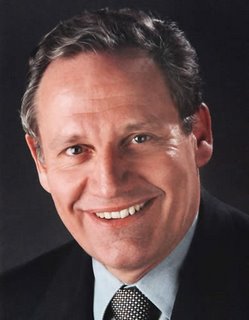 On Sixty Minutes last week, Bob Woodward (you remember, the guy who with buddy Carl Bernstein broke the Watergate story and inspired a generation of journalists) said the US military had a secret weapon that was akin to the tank or the airplane in the evolution of warfare.
On Sixty Minutes last week, Bob Woodward (you remember, the guy who with buddy Carl Bernstein broke the Watergate story and inspired a generation of journalists) said the US military had a secret weapon that was akin to the tank or the airplane in the evolution of warfare.In an interview with Scott Pelley, Woodward said he knew the secret but couldn't reveal it. The surge in Iraq had worked, Woodward said, not because of the increase in troops but because of a new technology that allows the military to locate and kill individual insurgents. He compared this "sophisticated and lethal special operations program" to the Manhattan Project, which developed the atomic bomb.
Terrific. What kind of fresh Orwellian hell is this? We know how much safer the atomic bomb the world. And of course we'll only use this wonderful new weapon against the bad guys, right? And nobody else will ever get it, right?
It is unsettling that a journalistic icon would withhold information. He said he was doing it out of a desire to protect lives, that to reveal the information would "get people killed." Okay, maybe. But if so, then probably best not to mention it at all. Unfortunately, it sounds more like he's been drinking the DOD's Kool Aid. I cannot imagine any program, short of the old (and discredited) Star Gate psychic intelligence, which would so dramatically change the face of warfare.
Friday, September 19, 2008
Take it easy
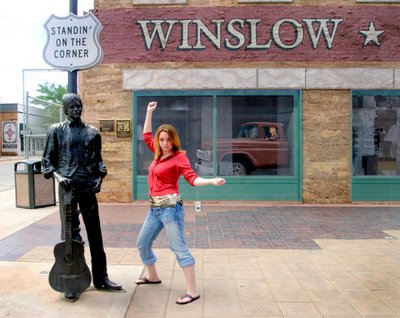 Long time no blog. Meanwhile, here's another image from the summer road trip. That's my youngest daughter standing on the corner in Winslow, Arizona. The chords of "Hotel California" were wafting from a loudspeaker across the street. Have always wanted to see this corner, and I'm glad I did, but can't say it was a religious experience. Seemed a bit tacky. Can't say the Eagles would approve. After gawking a bit, we were back on the road in the Jeep to Santa Rosa, New Mexico, where I strapped on scuba gear and dove the Blue Hole.
Long time no blog. Meanwhile, here's another image from the summer road trip. That's my youngest daughter standing on the corner in Winslow, Arizona. The chords of "Hotel California" were wafting from a loudspeaker across the street. Have always wanted to see this corner, and I'm glad I did, but can't say it was a religious experience. Seemed a bit tacky. Can't say the Eagles would approve. After gawking a bit, we were back on the road in the Jeep to Santa Rosa, New Mexico, where I strapped on scuba gear and dove the Blue Hole.
Wednesday, September 3, 2008
Okay, maybe a little sympathy...
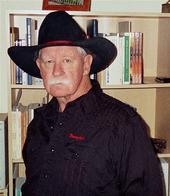 My friend, Red Shuttleworth, is in the wonderful habit of sending me real letters on real paper. The other day he sent me a few lines about I, QUANTRILL.
My friend, Red Shuttleworth, is in the wonderful habit of sending me real letters on real paper. The other day he sent me a few lines about I, QUANTRILL."You gain sympathy for Quantrill," he says. "Back in playwriting school, there was an exercise called Villian's Worst Deed: the point was to wrtie a sympathetic monologue for someone beyond redemption. Few writers can pull this off. You carried Quantrill into the landscape of the tragic, for he was morally equal to his adversaries... your Quantrill has an equal legitimacy to exist. That took splendid writing."
He also says some nice things about some minor characters, including Blue Fugate and Mary Culhain.
"Great work," Red says. "No straw men or straw ideas. Just straight-ahead great, daring writing."
Praise indeed from Red, who is no slouch when it comes to writing.
His praise includes: Best Living Western Poet -- True West, 2007. 1st Spur Award for Poetry -- Western Writers of America, 2001. "Like Cormac McCarthy..." -- Kirk Robertson, 2000. "Shuttleworth emerges as the true Western hero." --Las Vegas City Life, 2000. "Red Shuttleworth is a phenomenon among literary figures of the American West." -- J.V. Brummels, 1997. Red Shuttleworth is the author of the Spur Award-winning Western Settings and numerous poetry chapbooks, including Backtrack, Brief Lives, and Doc Holliday's Skeleton Takes a St. Patrick's Day Walk, Leadville, Colorado, 1887. Red's plays have been presented at the Utah Shakespearean Festival, Sundance Playwrights Lab, the Sun Valley Festival of New Western Drama, the Churchill Arts Council (Nevada), and at many other professional and academic theatres. Red's poems have appeared in over 200 journals, including South Dakota Review, New Letters, Ontario Review, Blue Mesa Review, True West, Concho River Review, Prairie Schooner, Rattle, Flyway, Elysian Fields Quarterly, Aethlon, Hubbub, and Suisun Valley Review.
By the way, Lawrence residents will have a chance to take another shot at me at the River City Reading Festival on Sept. 27.

Sympathy for the devil?
"It is difficult to believe we need a book purporting to show the 'human side' of William Quantrill, who led the devastating 1863 raid on Lawrence," the Journal-World said in an editorial. "Who really cares, except perhaps devotees of the Confederacy, who still are inclined to consider this murderer a hero."
I'm flattered, of course. Despite the claims that nobody cares, the Journal-World did devote a rather lengthy article and an editorial full of righteous bluster to my novel. But my goal was not to create sympathy for the devil.
But if the Journal-World editorial board had actually read my damned book, they would have known that already. The novel is not an apologetic. It is intended as a bloody and gritty and sometimes surreal first-person account of the last weeks of the infamous guerrilla's life. It is, if anything, an indictment of the cycle of violence of which the raid on Lawrence was a part. And it doesn't let Quantrill off the hook -- in the end, paralyzed and waiting for death, he recognizes his culpability, and is damned by it.
"The 244-page book notes that Quantrill died in 1865 in Kentucky after being shot by Union supporters," the editorial continues. "Most of us familiar with the depth and scope of the atrocities committed in that 1863 slaughter are inclined to hope he suffered."
After 145 years, so apparently is Lawrence.
Wednesday, August 13, 2008
No blood spilled in Lawrence
 Not a shot was fired when I addressed a near-capacity crowd in the auditorium of the Lawrence Public Library last night.
Not a shot was fired when I addressed a near-capacity crowd in the auditorium of the Lawrence Public Library last night.Of course, I really wasn't worried, despite the spirited online discussion on the Lawrence Journal-World website following their story about my attempts to "humanize" William Clarke Quantrill, who burned Lawrence 145 years ago this month. A few posters, apparently angry that I had attempted to portray Quantrill as a human being in my novel rather than a monster, had threatened (anonymously, of course) to teach me a lesson during my visit to Lawrence.
Alas, none showed up. I was all prepared to give my "American Bosnia" lecture about the Civil War on the Border.
Instead, I got an enthusiastic and particularly well-behaved crowd who listened to me talk about my work for over an hour, then asked terrific questions. That was followed by a book signing hosted by The Raven Book Store, a Lawrence institution and a particularly good place to find a mystery novel or works of regional interest. It was a pleasure to meet Lisa and Heidi, the new owners of the shop, and I hope someday in the not-too-distant future I can bring my characters Richard Dahlgren (THE MOON POOL) or Andy Kelsey (HINTERLAND) back in new adventures so I can have signings there.
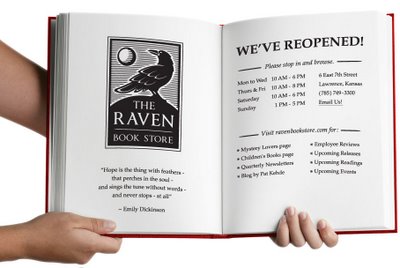 I have always believed that public libraries are a vital part of the cultural and intellectual life of any community, and I was grateful for such a good turnout in Lawrence. Thanks are particularly due to library liason Maria, who organized the event and made sure the word got out. Terry Rombeck's story in the Journal-World lead the arts section, and was teased above the flag on 1A. The appearance was part of Civil War on the Western Frontier, which goes through Aug. 21, the anniversary of the raid.
I have always believed that public libraries are a vital part of the cultural and intellectual life of any community, and I was grateful for such a good turnout in Lawrence. Thanks are particularly due to library liason Maria, who organized the event and made sure the word got out. Terry Rombeck's story in the Journal-World lead the arts section, and was teased above the flag on 1A. The appearance was part of Civil War on the Western Frontier, which goes through Aug. 21, the anniversary of the raid.I'll be be back in Lawrence on Saturday, Sept. 21, for the River City Reading Festival. A partial list of other authors slated to appear are Thomas Frank, Michael L. Johnson, Candice Millard, Scott Heim, Scott Phillips, Steven Hind, Jim Hoy, Kevin Rabas, and Denise Low.
Tuesday, August 12, 2008
Another raid on Lawrence
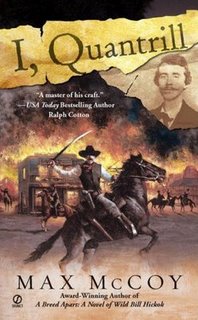 At 7 p.m., if I'm not assassinated, I'm going to speak and sign books at the Lawrence (Kansas) Public Library. The Lawrence Journal-World ran a story today on my appearance, under the head Devil's Advocate: Emporia author seeks to humanize Quantrill. This story has generated dozens of comments on the Journal-World's site, and a surprising amount of passion, regarding my novel, I, QUANTRILL.
At 7 p.m., if I'm not assassinated, I'm going to speak and sign books at the Lawrence (Kansas) Public Library. The Lawrence Journal-World ran a story today on my appearance, under the head Devil's Advocate: Emporia author seeks to humanize Quantrill. This story has generated dozens of comments on the Journal-World's site, and a surprising amount of passion, regarding my novel, I, QUANTRILL.Take this post, for example:
This publicity-seeker's 15 minutes of fame isn't going to change (W.E. Connelly's 1910 portrayal of Quantrill). I'll tell you one thing: If this guy had been born a lot earlier and had shown up in Lawrence to promote a book like this even as late as the 1940's, he'd have been tarred and feathered and run out of town on a rail.
Okay. Perhaps I should repeat that my book is a novel, not history, and it is told from the point-of-view of the fevered dream of a dying man. Yes, I did a lot of research for it, but I wasn't trying to defend W.C.Q. It's a novel. And Quantrill wasn't all bad.
The post continues:
I happen to be out of town right now, but were I in Lawrence I would without a doubt show up at this guy's love-fest and make him wish that he'd stayed in Emporia for the day. As it is, when I return I will put it on my list to reread the copy of Connelly that has been in my family since it was published, so as never to forget the real William Clarke Quantrill and what happened in my forebears' beloved city on August 21, 1863.
Love-fest? Really.
There are some posters who are pointing out that Quantrill was not much better than Jim Lane, who raided Missouri and hid in a cornfield during the Lawrence Raid. There were a lot of atrocities to go around. It was war. And the cycle of violence continued for generations. But the point is that I, QUANTRILL is a novel, which means it is a fiction. I am drawn to writing about individuals that society has labeled as monsters. Such as Civil War serial killer Alf Bolin in HELLFIRE CANYON, which won the Spur award from the Western Writers of America.
Oh, well. I hope some of these posters actually show up at the library. Perhaps some of them will actually read the damned book. And by the end they'll find out that what my Quantrill did, even in his own mind, was unpardonable.
For an impartial newspaper review from someone who has actually read the book, click here.
Monday, August 11, 2008
Here's your shirt
 There's a tiny icon of a tee-shirt next to some stories at the CNN website. They started popping up earlier this spring and I had no damned idea what they were until I finally clicked on one of them and discovered you could order a tee-shirt (for only $15, plus shipping) featuring the story's headline with a tagline that says, I just saw it on CNN. Now, not just any headline can be made into a shirt.
There's a tiny icon of a tee-shirt next to some stories at the CNN website. They started popping up earlier this spring and I had no damned idea what they were until I finally clicked on one of them and discovered you could order a tee-shirt (for only $15, plus shipping) featuring the story's headline with a tagline that says, I just saw it on CNN. Now, not just any headline can be made into a shirt.There is apparently some litmus test the CNN applies to determine if the shirt-worthiness of a headline. "Nude man, cops tussle in gas station" was a lock this week. So was, "Farmer erects 'Redneck Stonehenge'" and "Snake slithers into weatherguy's pants." But the only headline offered today on a shirt was, "Vet shortage could cripple food supply." Okay, guess somebody at CNN has seen Soylent Green or the classic Twilight Zone episode, "To Serve Man."
But here are today's headlines that, inexplicably, aren't offered as shirts:
Bush hugs bikini-clad Olympians.
Bush wants to alter Endangered Species Act.
and
Russian military pushes into Georgia.
Sunday, July 20, 2008
Canyon Diablo
 Here's the setting for the sequel to HELLFIRE CANYON. It's called Canyon Diablo, and it's a ghost town now, but in the 1880s it was considered by some to be the meanest town in the west. My editor and I visited the location on June 11, on our way to Scottsdale. Below is a shot of my Jeep, El Cabrito Loco, at the rim of the canyon, the ruins of a rock building nearby, and a photo showing the old Route 66 bridge crossing Canyon Diablo. The site is on the Navajo Reservation, and there are plans to turn the ghost town into a tourist attraction.
Here's the setting for the sequel to HELLFIRE CANYON. It's called Canyon Diablo, and it's a ghost town now, but in the 1880s it was considered by some to be the meanest town in the west. My editor and I visited the location on June 11, on our way to Scottsdale. Below is a shot of my Jeep, El Cabrito Loco, at the rim of the canyon, the ruins of a rock building nearby, and a photo showing the old Route 66 bridge crossing Canyon Diablo. The site is on the Navajo Reservation, and there are plans to turn the ghost town into a tourist attraction.
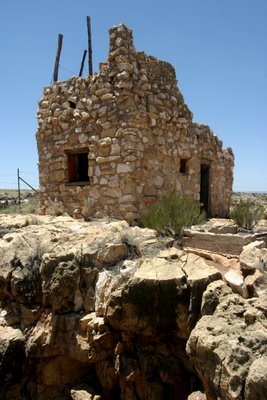

Friday, July 18, 2008
Postcard IV
Postcard III
Postcard II
Postcard from the Edge
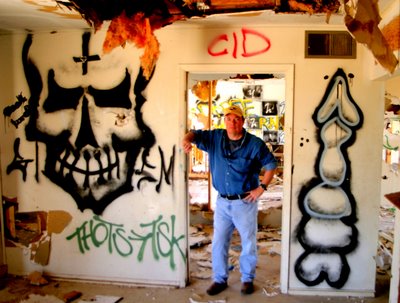 Long time no blog. Busy. Have lots of photos from the road trip through Colorado, Arizona, and New Mexico in June to share. This photo was taken by my editor, Gary (also known as Ice G) at an abandoned KOA on the road leading to the ghost town of Canyon Diablo. I have no idea what the grafitti means, but it is visually interesting. There's a skull, the Spanish word for lord or master, and a chess piece, maybe a bishop.... The place is between Flagstaff and Winslow on I-40, at the Two Guns exit. It is literally an exit to nowhere. There's no town, no paved roads, nothing. Except art.
Long time no blog. Busy. Have lots of photos from the road trip through Colorado, Arizona, and New Mexico in June to share. This photo was taken by my editor, Gary (also known as Ice G) at an abandoned KOA on the road leading to the ghost town of Canyon Diablo. I have no idea what the grafitti means, but it is visually interesting. There's a skull, the Spanish word for lord or master, and a chess piece, maybe a bishop.... The place is between Flagstaff and Winslow on I-40, at the Two Guns exit. It is literally an exit to nowhere. There's no town, no paved roads, nothing. Except art.
Monday, June 30, 2008
Reflected light
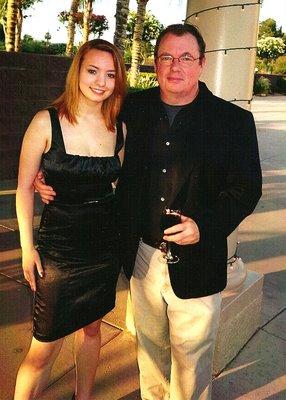 Here's what may be my favorite photo from the WWA Convention at Scottsdale, and it was taken by my friend Red Shuttleworth with a disposable camera. I'm with my daughter, Meg, outside the convention center just before the Spur Awards banquet. Red is a poet from Moses Lake, Washington. A few years ago, he was the very first to win a Spur for poetry. He also has 1,320 friends on My Space. I have 18, including some guy named Tom. He blesses all of his friends with poetry bulletins. Here's the first couple of lines of his latest:
Here's what may be my favorite photo from the WWA Convention at Scottsdale, and it was taken by my friend Red Shuttleworth with a disposable camera. I'm with my daughter, Meg, outside the convention center just before the Spur Awards banquet. Red is a poet from Moses Lake, Washington. A few years ago, he was the very first to win a Spur for poetry. He also has 1,320 friends on My Space. I have 18, including some guy named Tom. He blesses all of his friends with poetry bulletins. Here's the first couple of lines of his latest: Buffered with cheap whiskey, an old man carries a 1960
Pee Wee Soccer Championship medal in his pocket.
By late afternoon he will hand it to a weeping boy
abandoned on a baseball diamond by his friends.
Go make friends with Red. He's a compulsively likeable fellow and true. And, he'll tell you a story. Or take your picture with your daughter when you need to see yourself reflected in the eyes of someone you love.
Sunday, June 29, 2008
Scribo* goes silent
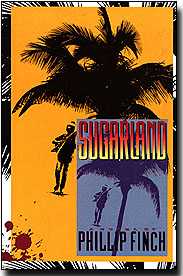 My friend Phillip Finch has discontinued his blog, Scribo* -- although I had already suspected as much, because the blog has been down for some time. Phil confessed during the annual Tallgrass Writing Workshop that had pulled the plug because it was a time sink. I've had the same fears about this blog. Whenever I post, I feel guilty. There are so many other things to do. And while I started out wanting to make it a photo blog, it has devolved into some weird cross between marketing and journaling, and does neither well. But, I won't give up just yet. Now that the hellish schedule of traveling and conferences that is June is all but past, I can see some time at the end of the tunnel. So, as a farewell (I hope temporarily) to Phil's blog, here's the cover of one of his novels, Sugarland, released in 1991 by St. Martin's Press. It is a first-rate book.
My friend Phillip Finch has discontinued his blog, Scribo* -- although I had already suspected as much, because the blog has been down for some time. Phil confessed during the annual Tallgrass Writing Workshop that had pulled the plug because it was a time sink. I've had the same fears about this blog. Whenever I post, I feel guilty. There are so many other things to do. And while I started out wanting to make it a photo blog, it has devolved into some weird cross between marketing and journaling, and does neither well. But, I won't give up just yet. Now that the hellish schedule of traveling and conferences that is June is all but past, I can see some time at the end of the tunnel. So, as a farewell (I hope temporarily) to Phil's blog, here's the cover of one of his novels, Sugarland, released in 1991 by St. Martin's Press. It is a first-rate book.
Voynich News reviews PHILOSOPHER'S STONE
Review of Indiana Jones and the Philosopher's Stone...
No, not the 2008 film (though that too has a crystal skull-based storyline): I'm talking about the 1995 book by Max McCoy, which Bantam have just (May 2008) reissued apropos of nothing (apart from perhaps trying to surf the wave of the film's gigantic marketing spend?)
The Voynich Manuscript makes its appearance very early on (p.27, actually the first page of Chapter 1): McCoy manages to present its history very lightly and not bog the reader down in too many details. But as the book is set in 1933, there wasn't a whole UFO angle to cover (or other such modern confections). Instead, you get a little bit of Newbold, Bacon, alchemy, Major John M. Manly (!!!), John Dee, Kelly, the Shew Stone, and even a quick reference to Wilfrid Voynich in New York: basically, everything moves briskly along in the kind of proper screenplay-like way you'd hope from an Indy novel. Yes, there's even the occasional snake (for readers playing Indy buzzword bingo, I guess).
I'll admit it: I was charmed by the book. It's small (293 pocket-size pages), no larger than you'd imagine a Japanese commuter squeezing into a pocket, and reads so quickly that at some points (most notably in the end sequence past the oasis) I deliberately closed my eyes to slow the pace down so that I could properly picture the scene in my mind.
Historically, the book has a deliciously light touch throughout, in particular when Indy and his companion are improbably rescued by an elderly French couple called Nicholas and Peronelle (p.200) - and if you can't work out who they are by that stage in the story, you very possibly deserve to be shot.
Thanks, Voynich News, for noticing. And sorry for calling you geeky.
Wednesday, June 18, 2008
Hardware
Saturday, June 14, 2008
Scottsdale signing
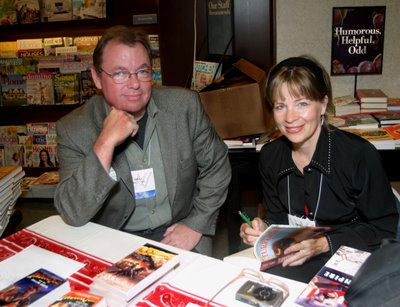 Here's a photo taken by my daughter Megan at the Western Writers of America book signing Saturday night at the Barnes & Noble at Scottsdale, Ariz. I'm sitting with Spring Warren, who is signing me a copy of her novel, Turpentine. Spring's novel was a Spur Award finalist. They placed us in front of the magazine rack, which seemed to annoy some customers. Spring comes by her name honestly, by the way -- she says her siblings are Meadow and Summer.
Here's a photo taken by my daughter Megan at the Western Writers of America book signing Saturday night at the Barnes & Noble at Scottsdale, Ariz. I'm sitting with Spring Warren, who is signing me a copy of her novel, Turpentine. Spring's novel was a Spur Award finalist. They placed us in front of the magazine rack, which seemed to annoy some customers. Spring comes by her name honestly, by the way -- she says her siblings are Meadow and Summer.
Thursday, June 12, 2008
Five Points
 A few days ago, on my way to a writing workshop at Gunnison, I paused at Five Points along the Arkansas River. It was a rainy, overcast day, and there were a few rafts on the river, and I took this photo with my Canon EOS 10D with a 70-200 2.8 L-series lens. It was just a grab shot, but I like the expression of the girl in the front of the raft. This apparently isn't everybody's idea of fun.
A few days ago, on my way to a writing workshop at Gunnison, I paused at Five Points along the Arkansas River. It was a rainy, overcast day, and there were a few rafts on the river, and I took this photo with my Canon EOS 10D with a 70-200 2.8 L-series lens. It was just a grab shot, but I like the expression of the girl in the front of the raft. This apparently isn't everybody's idea of fun.
Saturday, May 31, 2008
HELLFIRE CANYON a Kansas Notable Book
 I haven't been in my office at school for a few days because I bought a terrific old Victorian house on Constitution Street in Emporia and have been busy hauling a zillion pounds of books and tools and guitar amplifiers into it from the places they've been stored for the past couple of years. When I did go into today (Saturdays are quiet and I can get some work done), I found a letter waiting for me from Christie P. Brandau, the state librarian of Kansas.
I haven't been in my office at school for a few days because I bought a terrific old Victorian house on Constitution Street in Emporia and have been busy hauling a zillion pounds of books and tools and guitar amplifiers into it from the places they've been stored for the past couple of years. When I did go into today (Saturdays are quiet and I can get some work done), I found a letter waiting for me from Christie P. Brandau, the state librarian of Kansas.Hellfire Canyon has been named a 2008 Kansas notable book.
"The Kansas Notable Books list was created to recognize the literary richness of our state," Brandau wrote. "It is a project of the Kansas Center for the Book at the State Library of Kansas. The annual selection of fifteen books reflecting Kansas cultural heritage features high quality titles with wide public appeal that are either written by a Kansas resident or about a Kansas-related topic. A committee considered the universe of eligible books published in 2007 and met over the course of several months to evaluate and discuss titles. The culmination of the commitee's work was a recommended list presented to the State Librarian for final decision.
"As a Notable Book author you are invited to participate in several events, including a reception at the State Library this summer at which the award will be presented by Governor Kathleen Sebelius (date to be announced), and a reception on Friday, September 26, 2008, in Lawrence on the eve of the River City Reading Festival."
Hellfire Canyon also won the Spur Award for best original paperback from the Western Writers of America. I'll received that award next month at the WWA Convention in Scottsdale, Ariz. My editor, Gary Goldstein, will also accept the award on behalf of Kensington Books.
I'm heading for the Writing the Rockies workshop at Western State College in Gunnison, Colo., in a few days, to give the keynote address. Then, I'm picking Gary up at the airport in Denver and we're going to road trip it to Scottsdale. Along the way, we're going to discuss a sequel to Hellfire Canyon, which might be called Canyon Diablo.
My association with Gary goes all the way back to The Sixth Rider, which was published by Doubleday in 1991 and won the Best First Novel award from WWA. Although that book was acquired by Greg Tobin, Gary was the line editor.
Monday, May 19, 2008
I, QUANTRILL review
Once a year, Max McCoy writes a novel in which he takes an iconic figure and peels back the layers of myth and legend to reveal a decidedly more interesting human being underneath.
"I, Quantrill," released this past week by Signet, is his 17th and, perhaps, his best book yet.
Over the past two decades, McCoy has had Jesse James tell his story through Mark Twain; he has sent an anxious Wild Bill Hickok to his first gunfight; and he has launched Indiana Jones' quest for the crystal skull.
McCoy is the author of historical Westerns, thrillers and four original Indiana Jones adventures. Earlier this spring, the Western Writers of America awarded "Hellfire Canyon," the Spur Award for best paperback original novel... McCoy has a way of clarifying complex subjects without oversimplifying them. His novels are thick with plot, alive with strong characterization, and rich with historic detail.
He goes on to quote Johnny D. Boggs:
"Max McCoy has a love for language," said South Carolina novelist Johnny D. Boggs, author of "The Hart Brand" and the Spur Award-winning "Doubtful Canon." "There's a rhythm to his sentences, great word choices, a wonderful cadence, superb imagery. His stories often flow like the lyrics to a good song. I'll often find myself reading his sentences two or three times because I admire them, and I'm trying to figure out how he does it."
Who can argue with that?
McCoy's decision to use a reviled (or revered) historic figure as a first-person narrator immediately engorges "I, Quantrill" with tension by putting the reader inside Quantrill's head and building a level of intimacy between reader and narrator that is both exciting and disturbing.
"Max McCoy is one of the top writers at work today in the Western field," Boggs said. "Max does sound historical research, and he puts his own twist in his novels. He has this knack for bringing historical figures to vibrant life, whether it's Wild Bill Hickok or Jesse James. He shows them for what they were: humane yet savage."
You can read the review in its entirety here.
Tuesday, May 13, 2008
"... but the movie'd make swillions!"
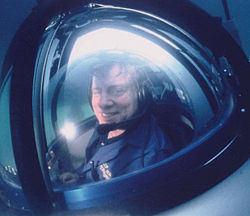 The following review came out in the June 29, 2007, issue of DIVER and it's by Phil Nuytten, the magazine's senior editor and the guy who invented the Newtsuit. Being busy with life, I missed the review. Also, it was three years since the release of The Moon Pool, so I really wasn't looking for it. But, I stumbled across the review yesterday on the Web, so here it is.
The following review came out in the June 29, 2007, issue of DIVER and it's by Phil Nuytten, the magazine's senior editor and the guy who invented the Newtsuit. Being busy with life, I missed the review. Also, it was three years since the release of The Moon Pool, so I really wasn't looking for it. But, I stumbled across the review yesterday on the Web, so here it is.The review isn't all gravy. Nuytten calls MP an "obvious piece of pulp fiction" (ouch!) and takes exception to some of technical stuff. Still, it's a good, honest review. And he seems to like it. Besides, who could argue with Phil Nuytten?
First, the hype from the publisher:
“Time is running out for Jolene. She’s trapped, naked, waiting only for her worst nightmares to become reality. Her captor is keeping her alive for twenty-eight days, hidden in an underwater city 400 feet below the surface. Then she will die horribly – like the others….”
‘Moon Pool’ takes its hat off and waves it at the Thomas Harris international best-seller “Silence of the Lambs” for premise and character types. It hallucinates in somewhat the manner of Carlos Castenada’s efforts and has bits reminiscent of Carl Hiassen or Elmore Leonard’s Florida-based master-trashies. It combines some off the wall humor with genuine cave-diving expertise, leading some to conjecture that author McCoy might have been influenced, or even partially corrupted by Cavin’-Maven Wes Skiles! (Ah, the wonderful pomposity of multiple literary references!)
Max McCoy is the award-winning author of nine books prior to ‘Moon Pool’. He’s a skilled, professional writer with a good handle on craft as well as style. There are a lot of ingredients in the Moon Pool omelette, but he deals with them in a deft manner. The long and short of it that this novel is well written. As I said, the guy is a pro. Like any good artist or composer, he knows exactly where to leave spaces that the readers can color in for themselves. Consider this piece of dialogue as the giant cavern’s topside supervisor talks to the French pilot of a mini-submersible called ‘Water Baby’:
“Bonjour”
“Welcome to the good earth,” McAfee said in French. “It is December fourteenth, the time is sixteen forty Zulu, and the temperature is always seventeen degrees. It’s wet here, but it never rains. We thought you might like to start with an orientation tour of
McAfee listened for a moment.
"But of course. Red or white?"
No biggie, but a good example. There’s also a dash of Robert Heinlein, or perhaps it’s more
McCoy knows that the standard sub design is a problem and, I’ll be darned if he doesn’t use it as a plot device! The pressure diff is critical to the story’s whirlwind ending: will it hold? Or will it ‘blow up good’ and atomize the hero and the shapely young thing that he has just untied from the railroad tracks? We thought our guy’d had it for sure a couple of times, but the author plucked him out of harm’s way with a couple of artful dodges, but this time… well, odds are that he and the naked lady ( yep, she’s nekkid as a new-born chick!) who he’s in the midst of salvaging, have truly had the biscuit! I mean, com’on. There’s no way they’re going to get out of this one… how can they?
Read the book.
P.S. If someone doesn’t make this puppy into a movie, they’re missing a bet. Think ‘Sea Hunt’, ‘American Pyscho’ and ‘Survivor’ mixing it up in ‘The Cave’ – whilst a bevy of nekkid, red-headed beauties arranged in Busby
I don't know exactly what a swillion is, but I'd like to find out. Now, go buy a subscription to DIVER!
Sunday, May 11, 2008
I, QUANTRILL Kindle edition
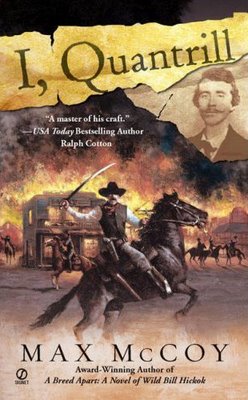 My new novel was released this week as an Amazon Kindle Edition. What's Kindle? Well, its a wireless digital delivery system that uses an electronic reader. It uses the same technology as your cell phone, so you don't need to find a WiFi hotspot -- you just need to be in range of a cell tower. And, Amazon promises, at no added fee beyond the purchase price. Here's the description from Amazon:
My new novel was released this week as an Amazon Kindle Edition. What's Kindle? Well, its a wireless digital delivery system that uses an electronic reader. It uses the same technology as your cell phone, so you don't need to find a WiFi hotspot -- you just need to be in range of a cell tower. And, Amazon promises, at no added fee beyond the purchase price. Here's the description from Amazon:Three years ago, we set out to design and build an entirely new class of device—a convenient, portable reading device with the ability to wirelessly download books, blogs, magazines, and newspapers. The result is Amazon Kindle. We designed Kindle to provide an exceptional reading experience. Thanks to electronic paper, a revolutionary new display technology, reading Kindle’s screen is as sharp and natural as reading ink on paper—and nothing like the strain and glare of a computer screen. Kindle is also easy on the fingertips. It never becomes hot and is designed for ambidextrous use so both "lefties" and "righties" can read comfortably at any angle for long periods of time.
We wanted Kindle to be completely mobile and simple to use for everyone, so we made it wireless. No PC and no syncing needed. Using the same 3G network as advanced cell phones, we deliver your content using our own wireless delivery system, Amazon Whispernet. Unlike WiFi, you’ll never need to locate a hotspot. There are no confusing service plans, yearly contracts, or monthly wireless bills—we take care of the hassles so you can just read.
So, you might ask, what do I think of Kindle? I don't know. It costs $400 bucks. I'm a little reluctant to part with four bills to see if this little device is all its promised to be -- you could buy a cheap laptop for that. So, if you have $403.79 burning a hole in your pocket ($399 for the Kindle, free shipping, and $4.79 for I, QUANTRILL) buy the gizmo and let me know. Tell me if you liked the novel and post a review on Amazon. And if you don't have that kind of disposable change, you could just spend $5.99 for my novel, which requires no batteries and you can slip in your back pocket without fear of sitting and breaking it.
Monday, May 5, 2008
The Dark Side
Going to the dark side is not an easy thing. I found it only mildly amusing when some newsroom wag immediately started a pool on when I would be indicted. Six months is the top slot so far, but at least one optimist chose eight months.
“Indicted or convicted?” I asked.
“Indicted,” the wag replied. “The odds on conviction are difficult to calculate.”
Indeed, it is ever so.
Indeed. Ed Simpson resigned recently, in the midst of an ever-widening sexual harassment investigation sparked by a series of stories in the Columbus Dispatch that has fellow Ohio Democrats clamoring for Dann's impeachment. The Associated Press today described "an atmosphere in Dann's office rife with inappropriate staff-subordinate relationships, heavy drinking and harassing and threatening behavior by a supervisor."On Friday, Dann also admitted to an extramarital affair with a subordinate -- but stubbornly hangs onto the job.
Dann's wife, Alyssa Lenhoff, is director of the journalism program at Youngstown State University. Lenhoff won several awards for investigative reporting at the Tribune Chronicle in Warren, Ohio. Lenhoff's former partner at the Tribune, Ed Simpson, was Dann's chief of staff until he resigned under fire on May 2, 2008.
| |
The above quote from Ed's last column was used by The Turner Report, a Joplin blog. Appropriately so. But there is more to Ed than
Sunday, April 20, 2008
The Surreal McCoy
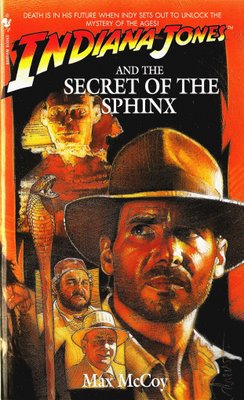 I was at Borders in Overland Park recently buying a Jodi Picoult novel for my eldest daughter (Nineteen Minutes, which debuted last year at #1 on the Times list) when I passed the prominent New Paperback table in the center of the store and there they were: My Indiana Jones novels. It has always made me feel a bit surreal to see my books on display, and being confronted by my cycle of Indy adventures, with the new covers with the raised lettering, magnified the effect. Then, on the way back home to Emporia, I stopped at a Dillon's store for a half-gallon of milk and again I passed the Indy books, in the middle of shelf of paperbacks you pass before you get to the checkout. Now, I suppose this should no longer surprise me. I knew Random House was bringing back the novels in time for the release of Indy IV. But I didn't think they'd be everywhere. No, it's not like debuting at the top of the Times list. But it's not like selling books out of the trunk of your car, either.
I was at Borders in Overland Park recently buying a Jodi Picoult novel for my eldest daughter (Nineteen Minutes, which debuted last year at #1 on the Times list) when I passed the prominent New Paperback table in the center of the store and there they were: My Indiana Jones novels. It has always made me feel a bit surreal to see my books on display, and being confronted by my cycle of Indy adventures, with the new covers with the raised lettering, magnified the effect. Then, on the way back home to Emporia, I stopped at a Dillon's store for a half-gallon of milk and again I passed the Indy books, in the middle of shelf of paperbacks you pass before you get to the checkout. Now, I suppose this should no longer surprise me. I knew Random House was bringing back the novels in time for the release of Indy IV. But I didn't think they'd be everywhere. No, it's not like debuting at the top of the Times list. But it's not like selling books out of the trunk of your car, either.
Tuesday, April 1, 2008
Sunshine in court
Our friends at the Federal of American Scientists Project on Government Secrecy have posted about The Sunshine in Litigation Act, which seeks to prevent court-approved secrecy agreements from hiding information that may be vital to the public health and safety. For more on the proposed legislation, including a link to the PDF of the Senate hearing on the bill, go the the FAS website.
Monday, March 31, 2008
First person paternal
Thursday, March 27, 2008
Revisiting the (underground) Ozarks
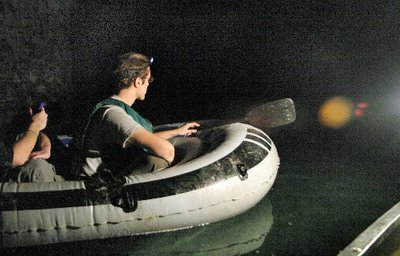 A couple of years ago, I spent an adventurous night with a group of college students who were fond of exploring forbidden places. The experience has stayed with me. Here's a bit of the story that appeared in The Joplin Globe.
A couple of years ago, I spent an adventurous night with a group of college students who were fond of exploring forbidden places. The experience has stayed with me. Here's a bit of the story that appeared in The Joplin Globe.CARTHAGE, Mo. -- Midnight. Lost in a labyrinth of rock and water.
"This happens every time," says White Rabbit casually as he dips his paddle into the water and propels the canoe a little further into the unknown. In the bow is Anne, a blond 17-year-old holding aloft a blazing Coleman lantern.
The brilliant light forces aside the darkness as if parting a curtain.
Everything looks the same: clear water tinged with a hint of green, massive pillars of gray rock, brown bats dotting the ceiling. A few bats flit overhead, disturbed by the passage of the 10 adventurers crammed into the canoe and two inflatable rafts.
The air is cool and the water colder, and the subterranean silence clings to the group as tightly as damp clothing. Even though this is their third illegal foray into the abandoned caverns at the edge of town, the group has been paddling around in a circle for nearly an hour, looking for anything familiar that might lead to the way out.
Sertile won't admit to being lost. Later, he will say, it was just a case of "spatial disorientation." Besides, they were only lost for about an hour.
In the past year, the group has ventured into areas that, for a variety of good reasons, are off limits to the public: Abandoned mines and mills across Missouri and Arkansas, the century-old Eighth Street tunnel in Kansas City, and a deactivated Nike missile battery near Pleasant Hill where the group managed to open the missile bay doors.
This sounds improbable, but they've posted video to prove it. It was a little strange, White Rabbit noted, to ride on an elevator designed for nuclear weapons.
The group's Web site, Underground Ozarks, is a combination bulletin board, travel diary, and photo album for urban exploration. The subculture is heavy with codes and aliases, and all nine members of the group identify themselves only by their online handles.
On this Saturday in the middle of October, the group has come to Carthage to gather more material and to probe around the edges of the massive underground storage facility owned by AmeriCold Logistics.
White Rabbit, an affable Missouri State University student from Springfield, doesn't care for the term "urban exploration." It's a $10 word for what nearly everybody has done, he says, at least at some point in their lives. It's about the satisfaction of going places where you don't belong and being able to brag about it later.
Tuesday, March 25, 2008
Found quote
Tuesday, March 18, 2008
James film among Spur winners
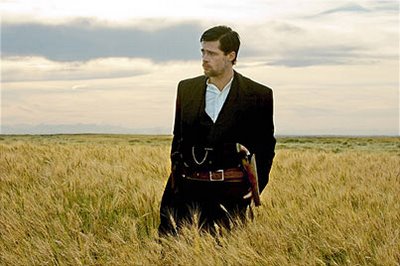
Other 2008 Spur winners include The God of Animals by Aryn Kyle (Scribner) and Tallgrass by Sandra Dallas (St. Martin's). The complete list can be found here.
Thursday, March 6, 2008
A Spur by any other name...
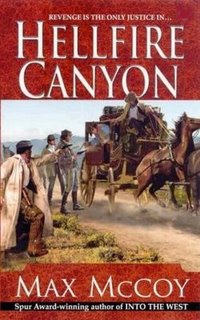 I was notified today that I've
I was notified today that I'veThe award is for a novel
Here's what the reviewer at Gravetapping Blog said last year:
"Hellfire Canyon is not the
play, but there is more—a
legend, and even folklore.
thief, but he—the story is
For some background
"The Spur Awards, given
Since then the awards have
Winners of the Spur Awards in
Wednesday, March 5, 2008
"...two words: governments lie."
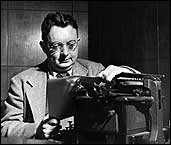 The Nieman Foundation at Harvard has created the I.F. Stone Award to honor journalistic independence.
The Nieman Foundation at Harvard has created the I.F. Stone Award to honor journalistic independence."The I.F. Stone Medal will be presented annuall to a journalist whose work captures the spirit of independence, integrity, courage and indefatigability that characterized I.F. Stone's Weekly, published 1953 - 1971," the foundation said this today in a press release. "Each year, the winner of the award will deliver a speech about his or how own experience with journalistic independence, to be followed by a workshop on the same topic."
So, who was I.F. Stone?
Well, the initials stand for Isidor Feinstein, his birth name. He added the Stone later. He was a muckraker who self-published his weekly newsletter and he died in 1989, at the age of 81. He was a left-leaning investigative reporter who taught himself Greek after retirement and wrote a book on the trial of Socrates. It's ironic that Harvard is honoring him, because for much of his life he was marginalized by the mainstream.
My favorite I.F. Stone quote?
"I am going to tell you a number of things, but if you really want to be a good journalist you only have to remember two words: governments lie."
Monday, March 3, 2008
Active Denial System? $13 million. Giving pesky peace protestors the hot foot? Priceless.
 I couldn't believe what I was seeing Sunday night. Was it 60 Minutes or an advertisement paid for by the Pentagon?
I couldn't believe what I was seeing Sunday night. Was it 60 Minutes or an advertisement paid for by the Pentagon?I've loved watching the venerable news program since I was a kid, and that's a long time. On Feb. 24, for example, the show did its usual bang-up job on a trio of stories: the politically-motivated bribery conviction of former Albama governor Don Siegelman, the killing of a black reporter who dared tell the truth about a corrupt local business, and the dire implications for all of us due to the disappearance of honey bees due to colony collapse disorder. Even when I don't agree with their approach, I love Morley Safer and Dan Rather and loved (the late) Ed Bradley. Hell, I even liked Diane Sawyer.
But this new guy, David Martin -- who has been the CBS Pentagon and national security correspondent since 1993 and has filed stories for 60 Minutes Wednesday, something I've never watched -- gave a breathless report on the Active Denial System, a non-lethal crowd control device that uses millimeter waves to create a burning sensation . Martin called it "The Ray Gun," and to demonstrate how effective the gadget was, Martin had himself repeatedly zapped by the thing. He writhed dramatically and cried out in pain. I used to hate this sort of thing when local television correspondents would volunteer to be hit with a Taser to show how safe they are (and it turns out they're not that safe). The angle of Martin's piece was that there's this wonderful new non-lethal gizmo that could be used in Iraq to save American lives, it has a range of half a mile, but the chowderheads in charge are refusing to embrace it because it isn't a lethal weapon. Fair enough. Problem is, what was presented as granted in the piece was that crowds (and by association, the right to free speech) must be controlled as a matter of national security.
My disbelief turned to anger when the device was aimed (in a test formulated by the military) at a group of soldiers pretending to be protestors. They were dressed in jeans and hoodies and carried badly-letter signs with slogans which called for world peace. What was implied, of course, is that peace activists are the enemy. They were rowdy, and some of them were throwing rocks at the vehicle upon which the ADS is mounted. Now, was it really necessary that any slogans be written on the signs for an effective demonstration? Blank signs would serve just as well. But then, the Pentagon would be denied the opportunity to slyly get their message across -- a message that was just as wrong in 1968 as in 2008, that "peace now" is code for anti-American. To be ethical, Martin should have declined to participate in, or use the video from, the military-controlled test. At the least, he should have asked those in charge why the enemy was portrayed as peace activists. But no, he couldn't stop gushing about the Pentagon's new toy.
Worse, Martin asked nary a question about whether this device would ever be used to disperse American crowds. Instead, he portrayed it as a way to read the minds of a crowd -- if anybody stays put after being stung with this thing, then they must be an imminent threat and subject to elimination by lethal force. What? If it won't really stop somebody intent on doing damage, then what the hell good is it? Well, it's good for stopping demonstrations and ending free speech, period, and if somebody struggles to keep that right, then they deserve to get shot. The police state isn't coming, it's here, because the news program I have trusted most to bring me the truth is now shilling for the Pentagon. The hard question here wasn't why the military hasn't deployed this thing in Iraq; the hard question is when the government intends to deploy it here.
It reminds me of William L. "Atomic Bill" Lawrence, a NYT reporter who was tapped to become the official correspondent for the Manhattan project. Lawrence, who won a couple of Pulitzers, earnestly (and wrongly) defended the military position that those who survived the bombings of Hiroshima and Nagasaki weren't really suffering any radiation sickness, it was just a ploy to drum up sympathy. It took a rebellious Austrailian journalist, Wilfred Burchett, to violate military orders and venture into ground zero to see for himself the radiation sickness, which he dubbed the "atomic plague." It makes me admire Austrailians more and value Pulitzers less.
Martin has been covering the Pentagon far too long. He no longer sees himself as somebody on the outside, but one of the insiders who is spreading the good news. He didn't even accurately describe how the damn thing works (it uses 96-GHz radio waves to excite molecules just beneath the skin; it doesn't use light or lasers, as the term "ray gun" implies). Martin demonstrated how the waves could penetrate plywood and a mattress, but if he'd had a basic understanding of science he would have used metallic mesh instead. But then, a tinfoil hat would just have looked silly on television -- and it would have given the enemy, those dirty dirty hippies, ideas about how to thwart the gadget.
Martin should go back to Wednesday night -- or better yet, he should go back to local news, where he can be zapped with Tasers during sweeps week until he soils his pants. What was 60 Minutes thinking? Perhaps they were trying to steal some viewers from Fox. By the way, this piece was produced by Mary Walsh, who -- big surprise -- has worked with Martin since he was assigned to the Pentagon.
Friday, February 15, 2008
Quantrill art
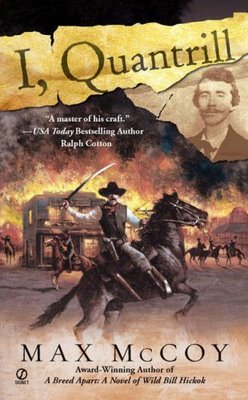 Here's the cover art for I, Quantrill. Usually I get this stuff from the publisher, but the first time I saw this cover was on Amazon, where I snagged the image. Because I tend to dislike my covers at first blush, I'll withhold comment for a little while. But at least they kept my title. A May 6 release date is planned.
Here's the cover art for I, Quantrill. Usually I get this stuff from the publisher, but the first time I saw this cover was on Amazon, where I snagged the image. Because I tend to dislike my covers at first blush, I'll withhold comment for a little while. But at least they kept my title. A May 6 release date is planned.I'm thinking of putting together a book tour to begin in Lawrence, Kansas, and end in (or near) Wakefield, Kentucky.
